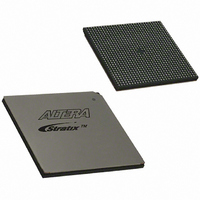EP1S40B956C5 Altera, EP1S40B956C5 Datasheet - Page 476

EP1S40B956C5
Manufacturer Part Number
EP1S40B956C5
Description
IC STRATIX FPGA 40K LE 956-BGA
Manufacturer
Altera
Series
Stratix®r
Datasheet
1.EP1S10F484I6N.pdf
(864 pages)
Specifications of EP1S40B956C5
Number Of Logic Elements/cells
41250
Number Of Labs/clbs
4125
Total Ram Bits
3423744
Number Of I /o
683
Voltage - Supply
1.425 V ~ 1.575 V
Mounting Type
Surface Mount
Operating Temperature
0°C ~ 85°C
Package / Case
956-BGA
Lead Free Status / RoHS Status
Contains lead / RoHS non-compliant
Number Of Gates
-
Available stocks
Company
Part Number
Manufacturer
Quantity
Price
Part Number:
EP1S40B956C5
Manufacturer:
ALTERA/阿尔特拉
Quantity:
20 000
- Current page: 476 of 864
- Download datasheet (11Mb)
Stratix I/O Banks
5–4
Stratix Device Handbook, Volume 2
LVDS
The LVDS I/O standard is a differential high-speed, low-voltage swing,
low-power, general-purpose I/O interface standard requiring a 3.3-V
V
data transfer, backplane drivers, and clock distribution. The
ANSI/TIA/EIA-644 standard specifies LVDS transmitters and receivers
capable of operating at recommended maximum data signaling rates of
655 Mbps. However, devices can operate at slower speeds if needed, and
there is a theoretical maximum of 1.923 Gbps. Stratix devices meet the
ANSI/TIA/EIA-644 standard.
Due to the low voltage swing of the LVDS I/O standard, the
electromagnetic interference (EMI) effects are much smaller than CMOS,
transistor-to-transistor logic (TTL), and PECL. This low EMI makes LVDS
ideal for applications with low EMI requirements or noise immunity
requirements. The LVDS standard specifies a differential output voltage
range of 0.25 V
input reference voltage, however, it does require a 100- termination
resistor between the two signals at the input buffer. Stratix devices
include an optional differential termination resistor within the device. See
Section I, Stratix Device Family Data Sheet
Volume 1
HyperTransport Technology
The HyperTransport technology I/O standard is a differential high-
speed, high-performance I/O interface standard requiring a 2.5-V
VCCIO. This standard is used in applications such as high-performance
networking, telecommunications, embedded systems, consumer
electronics, and Internet connectivity devices. The HyperTransport
technology I/O standard is a point-to-point standard in which each
HyperTransport technology bus consists of two point-to-point
unidirectional links. Each link is 2 to 32 bits. See the Stratix Device Family
Data Sheet section of the Stratix Device Handbook, Volume 1 for the
HyperTransport parameters.
LVPECL
The LVPECL I/O standard is a differential interface standard requiring a
3.3-V V
graphics, telecommunications, data communications, and clock
distribution. The high-speed, low-voltage swing LVPECL I/O standard
uses a positive power supply and is similar to LVDS, however, LVPECL
has a larger differential output voltage swing than LVDS. See the Stratix
Device Family Data Sheet section of the Stratix Device Handbook, Volume 1
for the LVPECL signaling characteristics.
CCIO
. This standard is used in applications requiring high-bandwidth
CCIO.
for the LVDS parameters.
The standard is used in applications involving video
×
V
OD
0.45 V. The LVDS standard does not require an
of the
Stratix Device Handbook,
Altera Corporation
July 2005
Related parts for EP1S40B956C5
Image
Part Number
Description
Manufacturer
Datasheet
Request
R

Part Number:
Description:
CYCLONE II STARTER KIT EP2C20N
Manufacturer:
Altera
Datasheet:

Part Number:
Description:
CPLD, EP610 Family, ECMOS Process, 300 Gates, 16 Macro Cells, 16 Reg., 16 User I/Os, 5V Supply, 35 Speed Grade, 24DIP
Manufacturer:
Altera Corporation
Datasheet:

Part Number:
Description:
CPLD, EP610 Family, ECMOS Process, 300 Gates, 16 Macro Cells, 16 Reg., 16 User I/Os, 5V Supply, 15 Speed Grade, 24DIP
Manufacturer:
Altera Corporation
Datasheet:

Part Number:
Description:
Manufacturer:
Altera Corporation
Datasheet:

Part Number:
Description:
CPLD, EP610 Family, ECMOS Process, 300 Gates, 16 Macro Cells, 16 Reg., 16 User I/Os, 5V Supply, 30 Speed Grade, 24DIP
Manufacturer:
Altera Corporation
Datasheet:

Part Number:
Description:
High-performance, low-power erasable programmable logic devices with 8 macrocells, 10ns
Manufacturer:
Altera Corporation
Datasheet:

Part Number:
Description:
High-performance, low-power erasable programmable logic devices with 8 macrocells, 7ns
Manufacturer:
Altera Corporation
Datasheet:

Part Number:
Description:
Classic EPLD
Manufacturer:
Altera Corporation
Datasheet:

Part Number:
Description:
High-performance, low-power erasable programmable logic devices with 8 macrocells, 10ns
Manufacturer:
Altera Corporation
Datasheet:

Part Number:
Description:
Manufacturer:
Altera Corporation
Datasheet:

Part Number:
Description:
Manufacturer:
Altera Corporation
Datasheet:

Part Number:
Description:
Manufacturer:
Altera Corporation
Datasheet:

Part Number:
Description:
CPLD, EP610 Family, ECMOS Process, 300 Gates, 16 Macro Cells, 16 Reg., 16 User I/Os, 5V Supply, 25 Speed Grade, 24DIP
Manufacturer:
Altera Corporation
Datasheet:












